主句谓语是think等的反意疑问句用法
英语反义疑问句的14种常考特殊用法,备战中考一定要掌握!
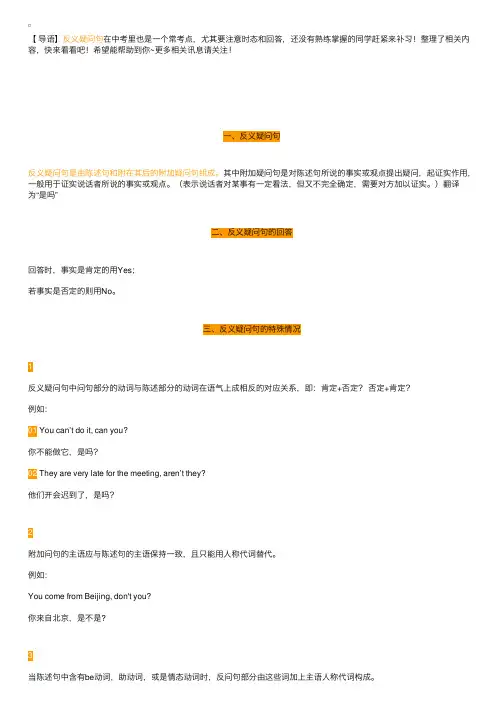
【导语】反义疑问句在中考⾥也是⼀个常考点,尤其要注意时态和回答,还没有熟练掌握的同学赶紧来补习!整理了相关内容,快来看看吧!希望能帮助到你~更多相关讯息请关注!⼀、反义疑问句反义疑问句是由陈述句和附在其后的附加疑问句组成。
其中附加疑问句是对陈述句所说的事实或观点提出疑问,起证实作⽤,⼀般⽤于证实说话者所说的事实或观点。
(表⽰说话者对某事有⼀定看法,但⼜不完全确定,需要对⽅加以证实。
)翻译为“是吗”⼆、反义疑问句的回答回答时,事实是肯定的⽤Yes;若事实是否定的则⽤No。
三、反义疑问句的特殊情况1反义疑问句中问句部分的动词与陈述部分的动词在语⽓上成相反的对应关系,即:肯定+否定?否定+肯定?例如:01 You can’t do it, can you?你不能做它,是吗?02 They are very late for the meeting, aren’t they?他们开会迟到了,是吗?2附加问句的主语应与陈述句的主语保持⼀致,且只能⽤⼈称代词替代。
例如:You come from Beijing, don't you?你来⾃北京,是不是?3当陈述句中含有be动词,助动词,或是情态动词时,反问句部分由这些词加上主语⼈称代词构成。
Be动词包括:am, is, are, was, were助动词有:do, does, did, have(⽤在完成时), has(⽤在完成时)等情态动词有:can, could, may, might, must, will, would, shall, should例如:01 He will go home, won’t he?他要回家了,是吗?02 She doesn’t like to eat popcorn, does she?她不喜欢吃爆⽶花,是吗?4have的不同⽤法,反义疑问句⽤不同的动词。
(1)have表“有”时,反义疑问句谓语动词⽤have/do都⾏。
否定疑问句的用法反意疑问句的用法详解
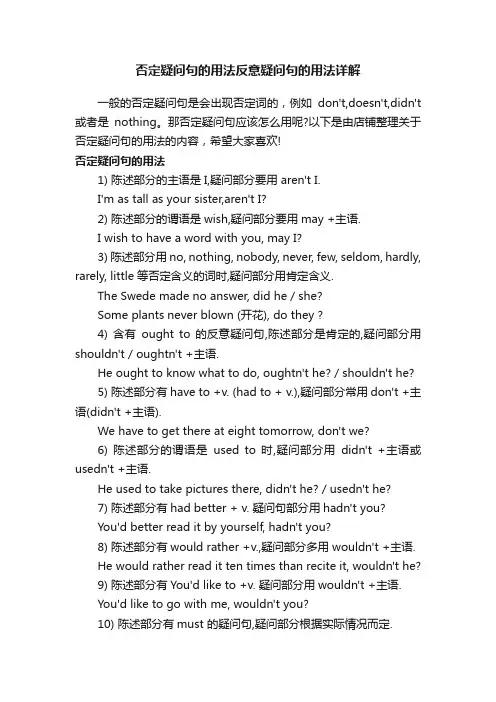
否定疑问句的用法反意疑问句的用法详解一般的否定疑问句是会出现否定词的,例如don't,doesn't,didn't 或者是nothing。
那否定疑问句应该怎么用呢?以下是由店铺整理关于否定疑问句的用法的内容,希望大家喜欢!否定疑问句的用法1) 陈述部分的主语是I,疑问部分要用 aren't I.I'm as tall as your sister,aren't I?2) 陈述部分的谓语是wish,疑问部分要用may +主语.I wish to have a word with you, may I?3) 陈述部分用 no, nothing, nobody, never, few, seldom, hardly, rarely, little等否定含义的词时,疑问部分用肯定含义.The Swede made no answer, did he / she?Some plants never blown (开花), do they ?4) 含有ought to 的反意疑问句,陈述部分是肯定的,疑问部分用shouldn't / oughtn't +主语.He ought to know what to do, oughtn't he? / shouldn't he?5) 陈述部分有have to +v. (had to + v.),疑问部分常用don't +主语(didn't +主语).We have to get there at eight tomorrow, don't we?6) 陈述部分的谓语是used to 时,疑问部分用didn't +主语或usedn't +主语.He used to take pictures there, didn't he? / usedn't he?7) 陈述部分有had better + v. 疑问句部分用hadn't you?You'd better read it by yourself, hadn't you?8) 陈述部分有would rather +v.,疑问部分多用 wouldn't +主语.He would rather read it ten times than recite it, wouldn't he?9) 陈述部分有You'd like to +v. 疑问部分用wouldn't +主语.You'd like to go with me, wouldn't you?10) 陈述部分有must 的疑问句,疑问部分根据实际情况而定.He must be a doctor, isn't he?You must have studied English for three years, haven't you? / didn't you?He must have finished it yesterday, didn't he?11) 感叹句中,疑问部分用be +主语.What colours, aren't they?What a smell, isn't it?12) 陈述部分由neither… nor, either… or 连接的并列主语时,疑问部分根据其实际逻辑意义而定.Neither you nor I am engineer, are we?13) 陈述部分主语是指示代词或不定代词everything, that, nothing, this, 疑问部分主语用it.Everything is ready, isn't it?14) 陈述部分为主语从句或并列复合句,疑问部分有三种情况:a. 并列复合句疑问部分,谓语动词根据邻近从句的谓语而定.Mr. Smith had been to Beijing for several times, he should have been in China now, shouldn't he?b. 带有定语从句,宾语从句的主从复合句,疑问部分谓语根据主句的谓语而定:He is not the man who gave us a talk, is he?He said he wanted to visit Japan, didn't he?c. 上述部分主句谓语是think, believe, expect, suppose, imagine等引导的定语从句,疑问部分与宾语从句相对应构成反意疑问句.I don't think he is bright, is he?We believe she can do it better, can't she?15) 陈述部分主语是不定代词everybody, anyone, somebody, nobody, no one等,疑问部分常用复数they,有时也用单数he.Everyone knows the answer, don't they? (does he?)Nobody knows about it, do they? (does he?)16) 带情态动词dare或need的反意疑问句,疑问部分常用need (dare ) +主语.We need not do it again, need we ?He dare not say so, dare you?当dare, need 为实义动词时,疑问部分用助动词do + 主语.She doesn't dare to go home alone, does she?17) 省去主语的祈使句的反意疑问句,疑问部分用will you.Don't do that again, will you?Go with me, will you / won't you ?注意: Let's 开头的祈使句,后用shall we?Let us 开头的祈使句,后用will you?Let's go and listen to the music, shall we?Let us wait for you in the reading-room, will you ?18) 陈述部分是"there be"结构的,疑问部分用there省略主语代词.There is something wrong with your watch, isn't there?There will not be any trouble, will there?19) 否定前缀不能视为否定词,其反意疑问句仍用否定形式.It is impossible, isn't it?He is not unkind to his classmates, is he?20)must在表"推测"时,根据其推测的情况来确定反意疑问句.He must be there now, isn't he?It must be going to rain tomorrow, won't it?。
反意疑问句的用法归纳
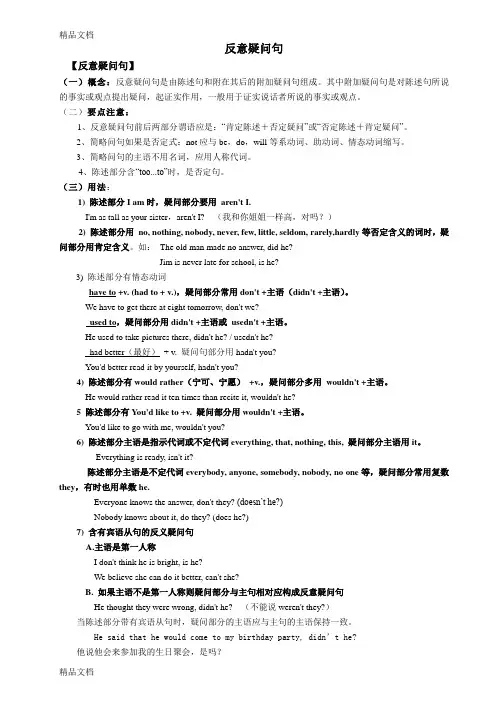
反意疑问句【反意疑问句】(一)概念:反意疑问句是由陈述句和附在其后的附加疑问句组成。
其中附加疑问句是对陈述句所说的事实或观点提出疑问,起证实作用,一般用于证实说话者所说的事实或观点。
(二)要点注意:1、反意疑问句前后两部分谓语应是:“肯定陈述+否定疑问”或“否定陈述+肯定疑问”。
2、简略问句如果是否定式:not应与be,do,will等系动词、助动词、情态动词缩写。
3、简略问句的主语不用名词,应用人称代词。
4、陈述部分含“too...to”时,是否定句。
(三)用法:1) 陈述部分I am时,疑问部分要用aren't I.I'm as tall as your sister,aren't I?(我和你姐姐一样高,对吗?)2) 陈述部分用no, nothing, nobody, never, few, little, seldom, rarely,hardly等否定含义的词时,疑问部分用肯定含义。
如:The old man made no answer, did he?Jim is never late for school, is he?3) 陈述部分有情态动词have to +v. (had to + v.),疑问部分常用don't +主语(didn't +主语)。
We have to get there at eight tomorrow, don't we?used to,疑问部分用didn't +主语或usedn't +主语。
He used to take pictures there, didn't he? / usedn't he?had better(最好)+ v. 疑问句部分用hadn't you?You'd better read it by yourself, hadn't you?4) 陈述部分有would rather(宁可、宁愿)+v.,疑问部分多用wouldn't +主语。
反义疑问句特殊用法总结
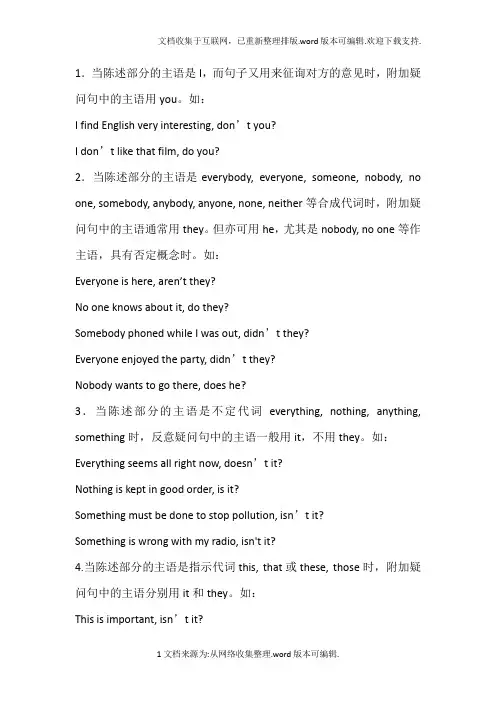
1.当陈述部分的主语是I,而句子又用来征询对方的意见时,附加疑问句中的主语用you。
如:I find English very interesting, don’t you?I don’t like that film, do you?2.当陈述部分的主语是everybody, everyone, someone, nobody, no one, somebody, anybody, anyone, none, neither等合成代词时,附加疑问句中的主语通常用they。
但亦可用he,尤其是nobody, no one等作主语,具有否定概念时。
如:Everyone is here, aren’t they?No one knows about it, do they?Somebody phoned while I was out, didn’t they?Everyone enjoyed the party, didn’t they?Nobody wants to go there, does he?3.当陈述部分的主语是不定代词everything, nothing, anything, something时,反意疑问句中的主语一般用it,不用they。
如:Everything seems all right now, doesn’t it?Nothing is kept in good order, is it?Something must be done to stop pollution, isn’t it?Something is wrong with my radio, isn't it?4.当陈述部分的主语是指示代词this, that或these, those时,附加疑问句中的主语分别用it和they。
如:This is important, isn’t it?That isn’t correct, is it?This is a plane, isn't it?These are grapes,aren't they?These are your friends Tom and Jack, aren’t they?5.如果陈述部分是以代词one作主语,附加疑问句中的主语在正式场合用one,非正式场合用you,在美国英语中,在非正式场合还可以用he。
几种特殊的反义疑问句1
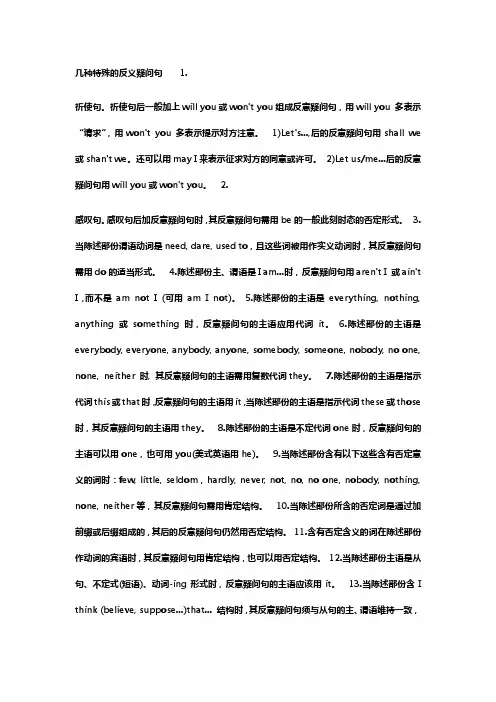
几种特殊的反义疑问句 1.祈使句。
祈使句后一般加上will you或won't you组成反意疑问句,用will you 多表示“请求”,用won't you 多表示提示对方注意。
1)Let's...,后的反意疑问句用shall we 或shan't we。
还可以用may I来表示征求对方的同意或许可。
2)Let us/me...后的反意疑问句用will you或won't you。
2.感叹句。
感叹句后加反意疑问句时,其反意疑问句需用be的一般此刻时态的否定形式。
3. 当陈述部份谓语动词是need, dare, used to,且这些词被用作实义动词时,其反意疑问句需用do的适当形式。
4.陈述部份主、谓语是I am...时,反意疑问句用aren't I 或ain't I ,而不是am not I (可用am I not)。
5.陈述部份的主语是everything, nothing, anything或something 时,反意疑问句的主语应用代词it。
6.陈述部份的主语是everybody, everyone, anybody, anyone, somebody, someone, nobody, no one, none, neither 时, 其反意疑问句的主语需用复数代词they。
7.陈述部份的主语是指示代词this或that时,反意疑问句的主语用it,当陈述部份的主语是指示代词these或those 时,其反意疑问句的主语用they。
8.陈述部份的主语是不定代词one时,反意疑问句的主语可以用one,也可用you(美式英语用he)。
9.当陈述部份含有以下这些含有否定意义的词时:few, little, seldom,hardly, never, not, no, no one, nobody, nothing, none, neither等,其反意疑问句需用肯定结构。
反义疑问句的14种常考特殊用法
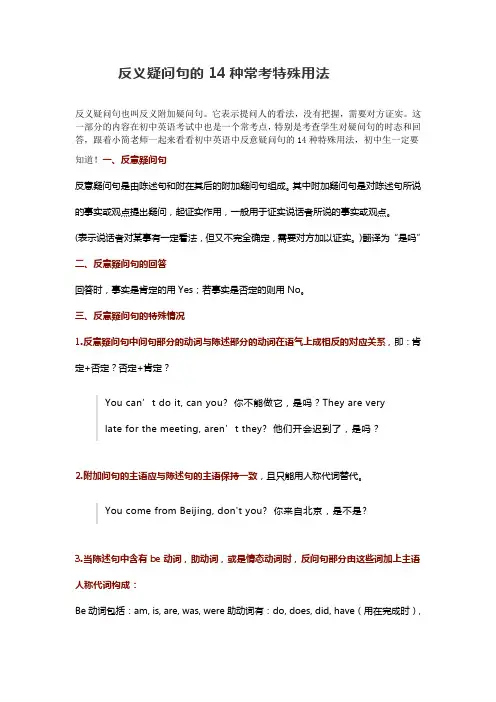
反义疑问句的14种常考特殊用法反义疑问句也叫反义附加疑问句。
它表示提问人的看法,没有把握,需要对方证实。
这一部分的内容在初中英语考试中也是一个常考点,特别是考查学生对疑问句的时态和回答,跟着小简老师一起来看看初中英语中反意疑问句的14种特殊用法,初中生一定要知道!一、反意疑问句反意疑问句是由陈述句和附在其后的附加疑问句组成。
其中附加疑问句是对陈述句所说的事实或观点提出疑问,起证实作用,一般用于证实说话者所说的事实或观点。
(表示说话者对某事有一定看法,但又不完全确定,需要对方加以证实。
)翻译为“是吗”二、反意疑问句的回答回答时,事实是肯定的用Yes;若事实是否定的则用No。
三、反意疑问句的特殊情况1.反意疑问句中问句部分的动词与陈述部分的动词在语气上成相反的对应关系,即:肯定+否定?否定+肯定?You can’t do it, can you? 你不能做它,是吗?They are verylate for the meeting, aren’t they? 他们开会迟到了,是吗?2.附加问句的主语应与陈述句的主语保持一致,且只能用人称代词替代。
You come from Beijing, don't you? 你来自北京,是不是?3.当陈述句中含有be动词,助动词,或是情态动词时,反问句部分由这些词加上主语人称代词构成:Be动词包括:am, is, are, was, were助动词有:do, does, did, have(用在完成时),has(用在完成时)等情态动词有:can, could, may, might, must, will, would, shall, shouldHe will go home, won’t he? 他要回家了,是吗?She doesn’tlike to eat popcorn, does she? 她不喜欢吃爆米花,是吗?4.have的不同用法,反义疑问句用不同的动词(1)have 表“有”时,反义疑问句谓语动词用have/do都行He has a new car, doesn’t/hasn’t he?(2)have表“吃,喝,玩,度过,举办”等是,反义疑问句谓语动词用doHe has supper at home every day, doesn’t he?They had agood time in Beijing, didn’t they?(3)have to表“不得不,必须”时,反义疑问句谓语动词用doKite has to help her mother, doesn’t she?(4)had better表“最好”时,反义疑问句谓语动词用hadWe had better go to school at once, hadn't we?(5)have用在完成时中,反义疑问句谓语动词用haveThey have known the matter, haven’t they?5.(1)反意疑问句的陈述部分带有little, few, never, hardly, seldom,nobody, nothing, no one, none, neither等否定意义的词时,问句部分用肯定式。
think引导宾语从句的反义疑问句
think引导宾语从句的反义疑问句“Think引导宾语从句的反义疑问句”确实是一个很有意思的话题。
我们知道,反义疑问句是由一个陈述句和与之相对立的一个否定或肯定的简短问句组成的。
而当think引导宾语从句时,我们可以通过构造反义疑问句来表达一种怀疑或质疑的语气。
下面我们就来详细探讨一下这个话题。
首先,让我们简单回顾一下think引导宾语从句的用法。
当我们在主句中使用think这个动词来表达自己的观点、看法或认识时,往往需要引导一个宾语从句来进一步说明或补充我们的观点。
比如,我们可以说“I think that he is a good person.”这里的“that heis a good person”就是一个由that引导的宾语从句,用来说明主句中的观点。
而当这个观点需要置疑或质疑时,我们就可以通过构造反义疑问句来表达出来。
以上面的例句为例,我们可以通过构造反义疑问句来表示怀疑或不确定的语气。
“I think that he is a good person, isn’t he?”这个问句中的“isn’t he”就是一个反义疑问句,用来对前面的陈述句进行质疑。
当然,我们也可以构造肯定的反义疑问句来表示自己对观点的坚定。
比如,“I think that he is a good person, isn’t he?”中的“isn't he”就是一个肯定的反义疑问句,用来对前面的陈述句进行肯定。
在实际应用中,我们可以根据语境和语气来选择合适的反义疑问句。
比如,在不确定自己的观点时,可以使用质疑的反义疑问句来表示怀疑;而在坚定自己的观点时,可以使用肯定的反义疑问句来表示确定。
当然,在构造反义疑问句时,还需要注意主谓一致、时态一致等语法规则。
总的来说,通过构造反义疑问句来表达对观点的怀疑或肯定是一种常见的语言表达方式。
在使用think引导宾语从句时,我们可以灵活运用反义疑问句来丰富自己的语言表达,使观点更加清晰和生动。
反义疑问句的用法总结
反义疑问句的用法总结相关热词搜索:反义疑问句的口诀反义疑问句复数法语反义疑问词反义疑问句宾语从句篇一:反义疑问句的用法一、基本用法与结构反意疑问句由两部分组成:前一部分是一个陈述句,后一部分是一个简短的疑问句,“陈述句+简略疑问句”。
第一部分提出一种看法,第二部分用来质疑或表示证实。
俩部分的人称时态应保持一致,陈述部分为肯定式时,疑问部分用否定式,陈述部分为否定式时,疑问部分用肯定式。
前肯后否,前否后肯。
You’re a student,aren’t you?M s smith isn’t a nurse, is she? (附加疑问句中的主语用主格)He can speakEnglish, can’t he? (附加疑问句中的主语用主格)He came early,didn’t he? (附加疑问句中的主语用主格)He likes English, doesn’t he? 他喜欢英语,是吗, (附加疑问句中的主语用主格)He doesn’t like English, does he? 他不喜欢英语,是吗, (附加疑问句中的主语用主格)【注】1. 若陈述部分含有seldom, hardly, never, few, litter, barely, scarcely, none, rarely, nothing,等否定词或半否定词,其疑问部分要用肯定式:He has few friends here, has he? 他在这儿几乎没什么朋友,是吗, She said nothing, did she? 她什么也没说,是不是,He can hardly swim, can he?They seldom come late, do they ?2. 若陈述部分含有带否定前缀un-, dis-, no-等,或者否定后缀:less,等表示否定意义的词如unhappy, dislike, unfriendly等,当看肯定句处理,疑问部分仍用否定式: The girl dislikeshistory, doesn’t she?It is unfair, isn’t it? 这不公平,不是吗?He looks unhappy, doesn’t he?It is impossible, isn’t it? 那是不可能的,是吗?二、反意疑问句的主语问题1. 基本原则:疑问部分的主语应与陈述部分主语一致,且只能是代词:误:Mary is a nurse, isn’t Mary?正:Mary is anurse, isn’t she? 玛丽是护士,对吗,2. 当陈述部分为there be句型时,疑问部分仍用there作“主语”: Be + thereThere was nothing in the room, was there? 房间里什么也没有,是吗, There are some apples in the desk, aren’t there?t any There isn’milk left, is there?3. 当陈述部分的主语是指示代词时,疑问部分用it, they等代词:That is a new car, isn’t it? 这是一辆新汽车,是吗?4. 当陈述部分的主语是复合不定代词时,为somebody, someone, everyone, everybody, no one, nobody等复合不定代词,其反意疑问句的主语在正式文体中用he,在口语或非正式文体中通常用they:Nobody was late, were they? 没有一个人迟到,是吗?当陈述部分的主语是 something, anything, nothing, everything等复合不定代词时,其反意疑问句的主语要用it:Everything is ready, isn’t it? 一切都准备好了吗,Nothing is important, is it? 没有什么重要的,不是吗?三、陈述部分有动词have的反意疑问句1. 当 have 为助动词时,其反意疑问句沿用同样的助动词:He has already left, hasn’t he? 他已经离开了,是吗?2. 当 have 为实意动词时,要分两种情况:? 若表示“所有”,反意疑问句可以用have,也可以用do:He has a lot of friends here, hasn’t [doesn’t] he? 他在这儿有许多朋友,是吗,但是若陈述部分用的是have的否定式,反意疑问句用have 还是用do,取决于陈述部分的动词形式:He hasn’t any money, has he? 他没有钱,是吗?He doesn’t have any money, does he? 他没有钱,是吗?? 若表示“吃”、“玩”等意思,反意疑问句要用do:He has supper at5, doesn’t he? 他5点吃晚餐,是吗?He had a goodtime at the party, didn’t he? 他在晚会上玩得很开心,是吗?3. 当用于have to时,通常也有两种可能:若表示经常性的行为,则多用加助动词do的形式;若表示特定的行为,则多用have:He often has toget up early, doesn’t he? 他经常要早起,是吗?He has to go tobed late tonight, hasn’t he? 他今晚要迟睡,是吗?四、含情态动词的反意疑问句1. 基本原则:在通常情况下,当陈述部分含有情态动词时,疑问部分会重复前面同样的情态动词:He can speakEnglish, can’t he,他会说英语,是吗,We shouldn’t go, should we? 我们不应该去,对不对,2. 当陈述部分含有must时,要分两种情况:? 若must表示“必须”或“有必要”,疑问部分用mustn’t 或needn’t:You must leave at once, mustn’t [needn’t] you? 你必须(有必要)马上离开,是吗?但是若陈述部分有mustn’t表示禁止,疑问部分要must:You mustn’t laugh, must you? 你不准笑,知道吗?? 若must表示推测,疑问部分不能用must,而应根据must后的动词结构采用相应的动词形式:He must be tired, isn’t he? 他一定累了,是吗?五、陈述部分为祈使句的反意疑问句1. 基本原则:若陈述部分为祈使句,疑问部分通常用will you:Please help us,will you? 请帮帮我们,好吗,Give me a hand ,will you?Come with us,will you? 同我们一起去,好吗,Don’t forget to post the letter, will you? 请别忘了寄信。
反义疑问句口诀
反义疑问句口诀【篇一:反义疑问句口诀】反意疑问并不难,陈述疑问句中含。
前后肯否恰相反,否定词缀不能算。
主谓时态要一致,特殊情况记心田。
实际情况来回答,再把yes 和 no 练。
综上所述,反义疑问句回答就是按实际情况回答。
对反意疑问句的回答,无论问题的提法如何,如果事实是肯定的,就用 yes ,事实是否定的,就要用 no 。
但是,翻译成汉语意思刚好相反,这种回答的 yes 要译成“不”,no 要译成“是”。
例:—he likes playing football, doesn’t he?他喜欢踢足球,不是吗?— yes, he does. / no, he doesn是’的t.。
/不是。
— his sister didn ’ t attend the meeting, did she? 他妹妹没有参加会议,是吗?— yes, she did. / no, she didn 不’,t她.参加了。
/ 是的,她没参加。
简要总结反意疑问句 19 条:(1) 陈述部分的主语是 i,疑问部分要用 arent i.im as tall as your sister,arent i?(2) 陈述部分的谓语是wish ,疑问部分要用may + 主语。
i wish to have a word with you, may i?(3)陈述部分用 no, nothing, nobody, never, few, seldom, hardly,rarely, little 等否定含义的词时,疑问部分用肯定含义。
the swede made no answer, did he / she?some plants never blown (开花), do they ?(4)含有 ought to 的反意疑问句,陈述部分是肯定的,疑问部分用shouldnt / oughtnt +主语。
he ought to know what to do, oughtnt he? / shouldnt he?(5) 陈述部分有have to +v. (had to + v.),疑问部分常用dont + 主语( didnt + 主语)。
i don't think be can drive加反义疑
i don't think be can drive加反义疑I don’t think he can drive的反义疑问句是can he?[解析] 句意:我认为他不会开车,是吗?含有think,believe,suppose,imagine,expect等表示主语主观意愿的词后接宾语从句构成的主从复合句在构成反意疑问句时,当主句的主语为第一人称时,其后的简短问句应与从句相一致。
并且当这些动词后接的宾语从句的否定转移到主句时,其仍属否定句,故其后的简短问句应用肯定式,而非否定式.本题否定在主句(I think是主句),主句否定意思在从句(I think后面是从句),反意在从句,因此用can he?[点评] can he?[点评] 1. 句型“I don’t think + 宾语从句”是含有否定转移/否定前置现象的主从复合句;2. 句型“I don’t think + 宾语从句”变反意疑问句时,必须根据宾语从句进行变化,而且宾语从句要视为否定句。
【资料拓展】1) I don’t think he is believable, ?A.do I B.is he C.isn’t he D.don’t I[解析] 句意:我认为他是不可信的,是吗?含有think,believe,suppose,imagine,expect等表示主语主观意愿的词后接宾语从句构成的主从复合句在构成反意疑问句时,当主句的主语为第一人称时,其后的简短问句应与从句相一致.并且当这些动词后接的宾语从句的否定转移到主句时,其仍属否定句,故其后的简短问句应用肯定式,而非否定式.因此用is he,故选B.[解答] B[点评] 1. 句型“I don’t think + 宾语从句”是含有否定转移/否定前置现象的主从复合句;2. 句型“I don’t think + 宾语从句”变反意疑问句时,必须根据宾语从句进行变化,而且宾语从句要视为否定句。
- 1、下载文档前请自行甄别文档内容的完整性,平台不提供额外的编辑、内容补充、找答案等附加服务。
- 2、"仅部分预览"的文档,不可在线预览部分如存在完整性等问题,可反馈申请退款(可完整预览的文档不适用该条件!)。
- 3、如文档侵犯您的权益,请联系客服反馈,我们会尽快为您处理(人工客服工作时间:9:00-18:30)。
反意疑问句的陈述部分为
I(We) think(believe,suppose,consider)+
that从句时,问句部分的动词及主语与that 从句内的动词和主语保持一致。
如:
①
I think that he has done his best, hasn’t he?
②
We think that English is very useful, isn’t it ? (不用don’t we?)
八、反意疑问句的陈述部分为I(We) don’t think(believe, suppose, consider )+ that从句时,从句为否定意义,问句部分的动词和主语仍与that从句保持一致且用肯定式。
如:
①
I don’t think that you can do it, can you? (不用do I?)
②
We don’t believe that the news is true, is it? (不用do we?)
九、反意疑问句的陈述部分为非第一人称主语+ think(believe, suppose, consider) + that 从句时,问句部分的动词和主语与陈述部分的主句动词和主语保持一致。
如:
①
They all think that English is very importan t, don’t they? (不用isn’t it?)
②
He didn’t think that the news was true, did he? (不用wasn’t/ was it?)。
